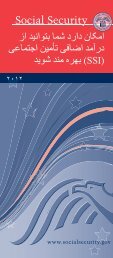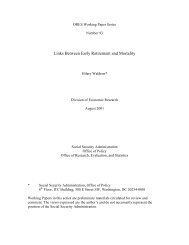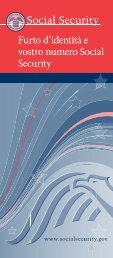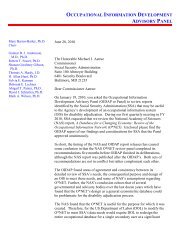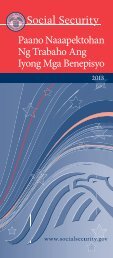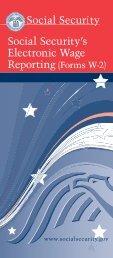Download entire publication - Social Security
Download entire publication - Social Security
Download entire publication - Social Security
Create successful ePaper yourself
Turn your PDF publications into a flip-book with our unique Google optimized e-Paper software.
Selected Abbreviations—continuedHSAIRSMEFMQGEOASDIP.L.QCSSASSBSSNHealth Savings AccountInternal Revenue ServiceMaster Earnings FileMedicare Qualified GovernmentEmploymentOld-Age, Survivors, and DisabilityInsurancePublic Lawquarter of coverage<strong>Social</strong> <strong>Security</strong> Administration<strong>Social</strong> <strong>Security</strong> Board<strong>Social</strong> <strong>Security</strong> numberPost Office Department (Corson 1938). Beginningin 1937, information on earnings up to the taxablemaximum of $3,000 was collected for all qualifiedindividuals. This was the maximum amount on whichboth employers and employees were required to paytheir share of taxes (1.0 percent each) under Title VIIIof the original <strong>Social</strong> <strong>Security</strong> Act. In the 1939 amendments,the taxing provisions were taken out of the<strong>Social</strong> <strong>Security</strong> Act and placed in the Internal RevenueCode as the Federal Insurance Contributions Act(FICA) (SSA 2009e). 4 FICA taxes (also called payrolltaxes) continue to be withheld from wages and earningsup to the taxable maximum, which has increasedover the past 70 years. For 2009, <strong>Social</strong> <strong>Security</strong> taxesare collected on earnings up to $106,800.Changes to CoverageThe <strong>Social</strong> <strong>Security</strong> Act stipulated who would becovered by the program, meaning those who wouldpay into the system while working and then receivebenefits in retirement. The types and numbers ofworkers covered by <strong>Social</strong> <strong>Security</strong> have changed overtime as more categories of workers have been addedto the rolls (see Chart 1). Under the original act, allworkers in commerce and industry (excluding railroads)were covered by the program. 5 In 1940, 24 millionworkers were in covered employment, whichwas approximately 52 percent of the employed laborforce (SSB 1944). Self-employment earnings informationwas first collected in 1951 when nonfarm selfemployedworkers (except members of professionalgroups) were added to the <strong>Social</strong> <strong>Security</strong> program.Additional groups of self-employed workers andprofessionals were added through legislation passed in1954, 1956, and 1965 (more information appears in theSelf-Employment Earnings section).Various types of agricultural and domestic workersand members of the uniformed services on activeduty were also added during the 1950s and 1960s,bringing the number of workers with taxable earningsto 92.1 million by 1970 (SSA 2008). The 1983 amendmentsto the act added newly hired federal employees,members of Congress, the president and vice president,and newly hired employees of nonprofit organizations.Today, approximately 96 percent of the U.S.workforce (including workers in American Samoa,Guam, the Northern Mariana Islands, Puerto Rico,and the U.S. Virgin Islands) participate in the <strong>Social</strong><strong>Security</strong> program (SSA 2008). 6 As more workers areadded to the program, SSA collects an increasingnumber of earnings records each year. The MEF currentlycollects earnings information on an annual basisfor about 160 million people working in the UnitedStates and its territories.Changes to the Taxable MaximumIn addition to changing coverage laws, changes to the<strong>Social</strong> <strong>Security</strong> program and <strong>Social</strong> <strong>Security</strong>-relatedtax laws have also affected the information containedin the MEF (see Chart 2). Since its inception, therehave been increases to the maximum income subjectto <strong>Social</strong> <strong>Security</strong> payroll taxes, which has resulted inhigher earnings amounts being stored in the MEF. Thefirst increase in the taxable maximum, from $3,000 to$3,600, occurred in 1951, and four additional increasesoccurred through 1971. The 1972 <strong>Social</strong> <strong>Security</strong>Amendments provided for annual increases in thetaxable maximum, proportional to the increase in thenational average wage, beginning in 1975. 7 Since 1978,earnings information has also been collected for workersand earnings not covered by the program and forthose with earnings above the taxable maximum (formore information on changes to the earnings data seethe Relevant Time Periods section).In this article “covered earnings” refers to thosefrom employment covered by <strong>Social</strong> <strong>Security</strong> or,more specifically, Old-Age, Survivors, and DisabilityInsurance (OASDI). “Noncovered earnings” refersto those from employment not covered by OASDI.Covered earnings below the taxable maximum arecalled “OASDI taxable earnings,” while those abovethe taxable maximum are referred to as “OASDInontaxable earnings.” A “quarter of coverage” (QC)is the basic unit for determining whether a worker isinsured under the <strong>Social</strong> <strong>Security</strong> program. Covered30 <strong>Social</strong> <strong>Security</strong> Bulletin • Vol. 69 • No. 3 • 2009



